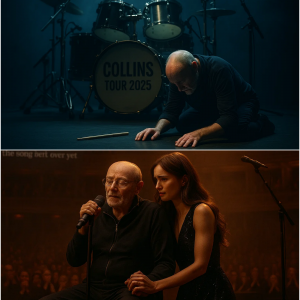The crowd gathered in downtown Nashville on a golden autumn afternoon, holding candles, flags, and guitars painted with Blake Shelton’s name. The air felt sacred — as if the city itself was holding its breath. And then, as the red curtain fell, a ten-foot bronze statue of BLAKE SHELTON stood revealed under the Tennessee sun.
He looked timeless — guitar in hand, head slightly bowed, that familiar warm smile forever captured in metal. It wasn’t just art. It was emotion cast in bronze.
For a moment, there was only applause. Then came the silence that follows awe — the kind that makes people realize they are witnessing history.

🌾 A TRIBUTE TO A HUMBLE LEGEND
The statue, located along Music Row, was designed not as a monument of fame, but of faith. Every detail spoke to who Blake Shelton truly was: a storyteller, a believer, and a man whose songs grew from the dirt roads of Ada, Oklahoma.
At its base were engraved words chosen by his family:
“For the dreamers who sing truth, even when no one’s listening.”
It was simple. Honest. Like him.
Blake’s longtime friend and sculptor Daniel Harrow said, “Blake didn’t want anything flashy. He told me, ‘Make it real. Make it look like the guy you’d meet in a diner at 6 a.m.’ And that’s exactly what we did.”
But when workers lifted the statue into place two days before the unveiling, something unexpected happened. Inside the hollow core of the sculpture — sealed behind a small bronze panel — they discovered a metal tube.
A capsule.
💌 THE SECRET INSIDE THE STATUE
At first, the team thought it might be part of the structure. But when Harrow examined it closely, he realized it was deliberate. The capsule bore a small engraving that read: “For the ones who will sing after me.”
Inside was a single folded letter, aged by time and sealed in wax. The ink was unmistakably Blake’s. The handwriting — firm, uneven, but familiar.
After consulting with the Shelton family, city officials decided the letter could be read aloud during the ceremony. As thousands of fans grew silent, Gwen Stefani, Blake’s wife, stepped forward with trembling hands and began to read.

❤️ BLAKE’S MESSAGE TO THE FUTURE
“If you’re holding this, it means music still matters.”
“I was never the best singer or the sharpest writer. But I was real. That’s all I ever wanted to be. If you ever stand on a stage, don’t sing to be perfect — sing to be honest. Sing for the people who can’t find the words themselves.”
“There’ll be days when your voice cracks. When no one claps. When you feel small. But remember — the world doesn’t need louder voices. It needs truer hearts.”
“I hope this statue doesn’t remind people of me. I hope it reminds them that even a farm boy from Oklahoma can make a sound big enough to reach heaven.”
“And if you ever get lost — come home. Ada’s still here. So am I, in every song that tries to heal something.”
When Gwen’s voice broke on the last line, even the toughest fans — bikers, veterans, teenagers — were seen wiping their eyes. It wasn’t just a letter. It was a goodbye wrapped in hope.
🎶 THE EMOTION BEHIND THE METAL
Historians and critics began calling it “the most human monument in Nashville.” For while statues often freeze legends in time, Blake’s did something more — it breathed. It spoke.
Art professor Lillian Crane said, “It’s rare for a monument to have a heartbeat. But this one does. That letter inside turns bronze into blood — it keeps him alive.”
The sculptor later confirmed that Blake himself had quietly asked for a small hollow chamber inside the statue but never explained why. “He just smiled and said, ‘Someday, people will need to find something inside me that still sings.’ Now I know what he meant.”
🌅 A LEGACY OF LIGHT
As the crowd lingered past sunset, a choir of young musicians — many from Blake’s charity programs — began softly singing “God Gave Me You.”
Parents lifted their children onto their shoulders. Veterans saluted. Gwen Stefani held a candle and whispered, “He’d be proud.”
When the final note faded, the lights reflected off the bronze guitar, glowing like it was made of fire.
🕊️ WHAT THE LETTER MEANS TODAY
For Nashville’s young dreamers, the discovery became more than a mystery — it became a mission. Music schools across Tennessee began teaching Blake’s letter as part of their songwriting courses. The phrase “Sing to be honest” started trending worldwide, printed on posters, T-shirts, and guitar cases.
Even country newcomer Mason Lee, 19, said tearfully, “I was going to quit music last year. But after hearing Blake’s letter, I realized — this is exactly why I started.”
The letter has since been preserved in a glass capsule near the statue’s base, inscribed with the words:
“The song never ends — it just changes voices.”

💖 THE FINAL NOTE
The mystery inside the statue wasn’t about fame or curiosity. It was about faith — faith that music could outlive the man who made it.
In a city built on melody and memory, Blake Shelton’s final message now stands eternal:
A reminder that truth still matters. That kindness still echoes. That even when the world moves too fast, a single honest song can still stop time.
And as the Nashville night grew quiet again, someone in the crowd whispered the line from his letter that no one will ever forget:
“If you ever get lost — come home.”





